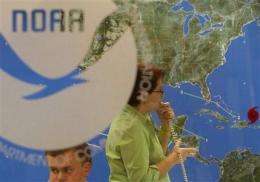Thanks to high-tech, storm track easier to predict

(AP) -- Sophisticated computer models that replaced instinct with cold, hard math have helped forecasters predict where a storm like Hurricane Earl is going about twice as accurately as 20 years ago.
And last year, they proved it: The three-day forecast was as accurate as the here-it-comes, one-day warning used to be in the 1980s. In the 2009 hurricane season, the one-day forecast predicting where a storm would hit was off by only 53 miles on average.
But Earl is the type of storm - big and in a tricky location - that can defy expectations. Its predicted track shows the eye passing just off the East Coast, dancing so close to shore that a slight wobble could turn that miss into a mess.
Even if the eye remains offshore, high winds that extend 200 miles from the center could reach inland.
A small shift could "bring the center of Earl directly in contact with the Outer Banks, hence the need for the (hurricane) warning," National Hurricane Center Director Bill Read said Wednesday.
East Coast storms can be more predictable than those in the Gulf of Mexico because they don't usually make the sharp twists and turns taken by some gulf storms.
Still, MIT meteorology professor Kerry Emanuel called Earl "a forecasting nightmare in a way."
That's why Read and others emphasize that the forecast isn't a precise projection of Earl's movements. It's a line surrounded by a "cone of uncertainty."
About one out of three times, the eye of the storm will move out of the cone, said Timothy Schott, tropical cyclone program leader for the National Weather Service in Silver Spring, Md.
"We're very confident about the track. We're confident about the intensity," Read said.
But because of uncertainties, the track can't be narrowed to "a skinny line on a map," he said. "That's why we have errors."
However, those errors are nothing compared with what they used to be.
When Max Mayfield joined the hurricane center in 1972, forecasters had some computer models, but their calculations were based more on history, not the physics of the current atmosphere.
Mostly forecasters used their knowledge and plain old "feel," said Mayfield, who later became the center's director and is now retired.
In 1972, the average two-day forecast was off by about 450 miles; last year it was 81 miles. The margin of error used to be so big that when a storm hit the Leeward Islands - far to the southeast of the U.S. - forecasters started alerts for Florida and up the East Coast, Mayfield said.
He credits the improved forecasts to better observations of storms and improved computer models.
"We have a lot more confidence in the models than we used to," Mayfield said.
Many - if not most - of the models now look at the shifting dynamics of the atmosphere to see what forces are guiding a hurricane. That type of calculation takes faster computers, which are now more readily available.
Hurricanes avoid high-pressure systems - which almost act like brick walls - and follow low pressure troughs, which act like bowling alley gutters guiding storms. The models essentially predict where the walls and gutters will be.
In some ways, those computer models have gotten so reliable that hurricane specialists half-jokingly grouse that they will soon become messengers instead of forecasters, said Hugh Willoughby, a professor at Florida International University and former head of the weather service's hurricane research division.
There are also far more computer models churning data and making predictions, said MIT's Emanuel. That makes a consensus more likely, he said.
But the weather service's Schott said that's only half the story. Despite years of research, forecasters still have not significantly improved their forecasts on storm intensity. They aren't certain why storms suddenly get weaker or stronger.
That's why planes and drones are continuously flown into Earl for more information, especially about the way energy is exchanged between the ocean and the storm itself, Schott said.
"While we pride ourselves that the track forecast is getting better and better, we remain humbled by the uncertainties of the science we don't yet understand," Schott said. "This is not an algebra question where there's only one right answer."
More information: National Hurricane Center: http://www.nhc.noaa.gov
©2010 The Associated Press. All rights reserved. This material may not be published, broadcast, rewritten or redistributed.
















